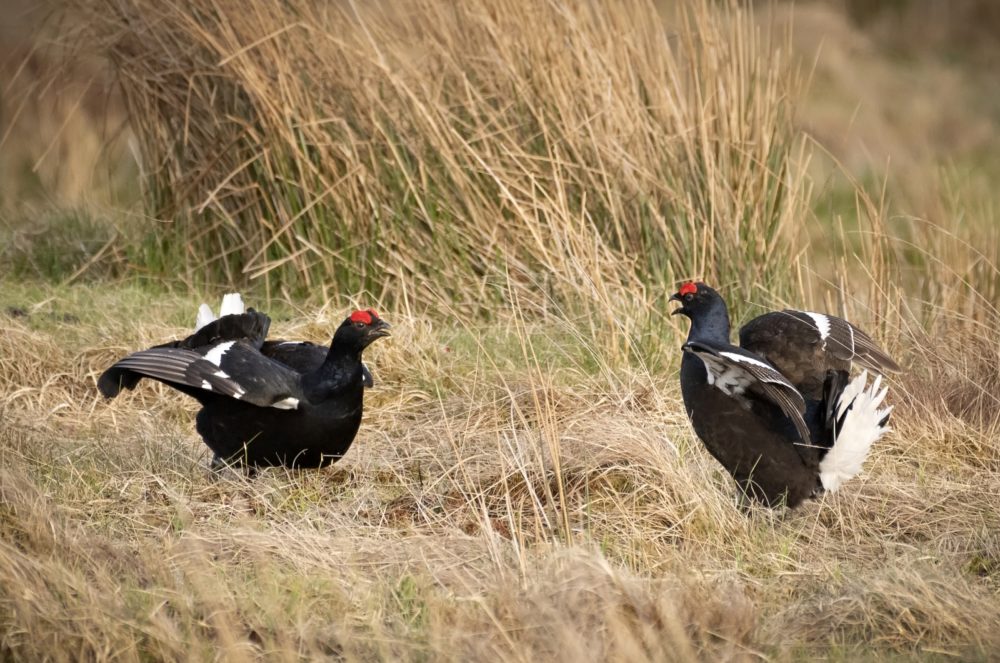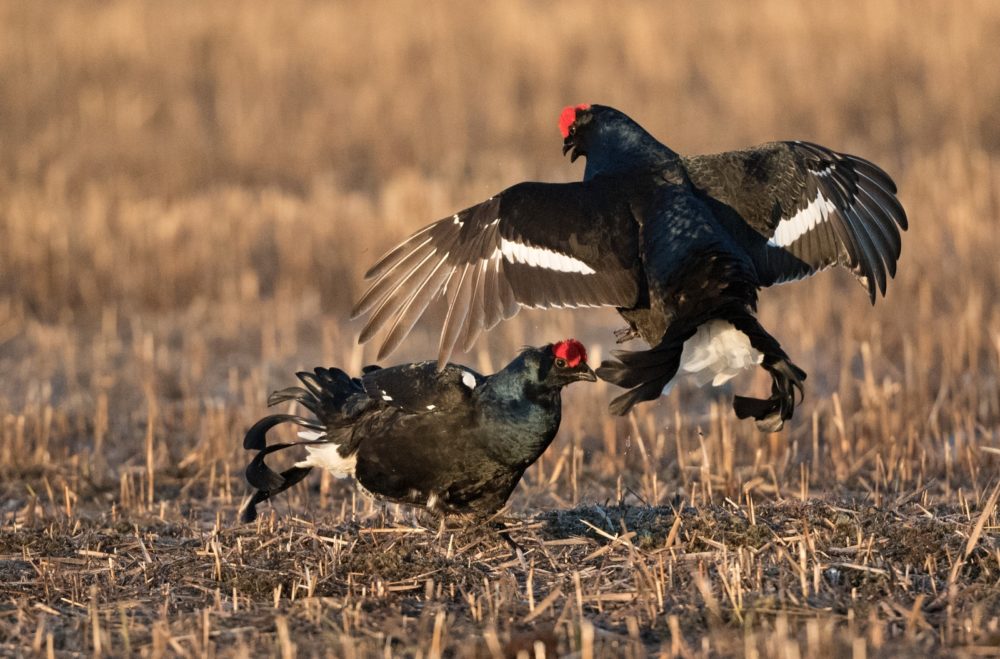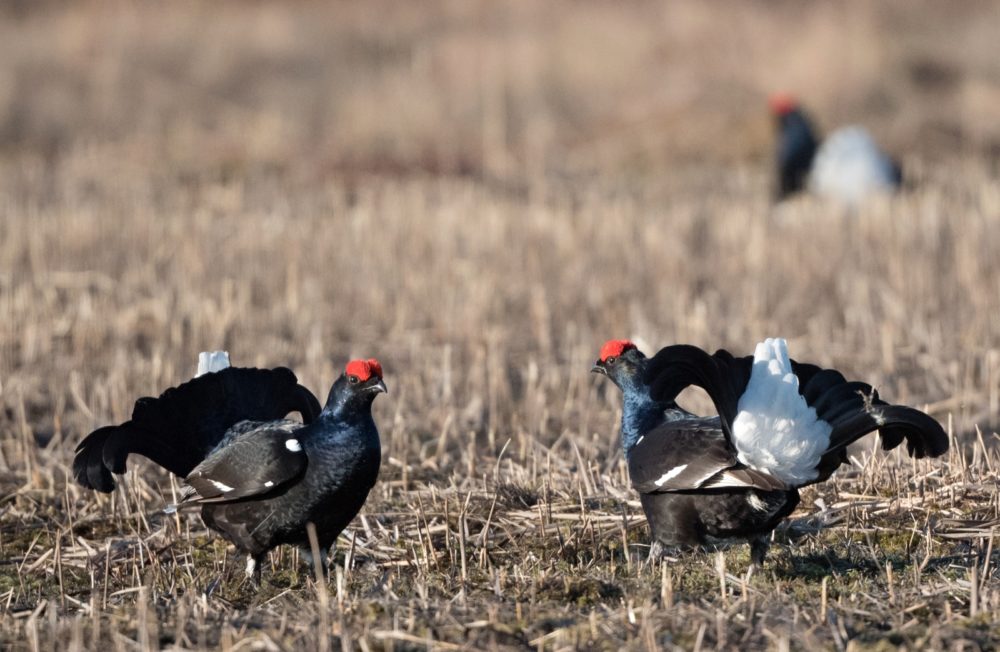An artificially-reared black grouse requires high-quality food to ensure its survival in the wild
Since the mid-twentieth century, the populations of grouses in the Czech Republic (ČR) and throughout Central Europe have decreased significantly. This trend is also evident in Scandinavia, which is the European centre of gravity for their habitat. The most noticeable reduction in numbers is seen in the black grouse population. Environmental changes, predation pressure, and other factors caused by human activity are the primary reasons for this decline. Nevertheless, increasing the number of surviving grouse in nature is a challenging task.
 Photo: Black grouse, Wikimedia Commons, licence CC 2.0, Author: Caroline Legg
Photo: Black grouse, Wikimedia Commons, licence CC 2.0, Author: Caroline Legg
One of the major issues in reintroducing burrowing birds to their natural habitats is their low biological quality and the ability of aviary-bred individuals to adapt to the wild living conditions. The primary goal is to ensure that the artificially reared and reintroduced birds can effectively search for and accept natural food. However, in reality, it has been observed that most of the released grouse were found dead or caught by predators, and they were significantly malnourished.
Scientists from the Department of Game Management at the FGMRI (VÚLHM, v. v. i.), have solved an important problem related to successful reintroductions. They achieved this within the framework of project No.TH04030524, which is the Model of Conservation and Development of Biodiversity of Grouse Habitats and Populations in the Area of Králický Sněžník (Model zachování a rozvoje biodiverzity stanovišť a populací tetřevovitých v oblasti Králického Sněžníku). This project was supported by the Technological Agency of the Czech Republic (TA ČR). Their findings have been published in an article titled “Improving the biological quality of black grouse (Lyrus tetrix) individuals prepared for rescue programs“ (Zvýšení biologické kvality jedinců tetřívka obecného připravovaných pro záchranné programy). This article was featured in the journal Reports of Forestry Research (Zprávy lesnického výzkumu) No. 4/2023. The article discusses how to strengthen populations that are already below the level of the biological minimum. Additionally, it addresses reintroductions in locations where the environment has been reconstructed.
Grouses’ food spectrum varies significantly throughout the year and is quite specific compared to other grouse species. Their digestive system is also adapted to these changes, with the double cecum (which is much longer than domestic chickens) playing a particularly important role. In winter, grouse mainly consume food that is difficult to digest and has a high cellulose content. During this time, their cecums are fully functional, compared to the vegetation season.
Scientists have discovered that Scottish hens, which are raised in captivity and fed with pellets, have caecums shortened by 48% and small intestines by 28% in comparison to their wild counterparts. This reduction in biological quality leads to increased mortality of artificially-reared grouse and grouse in the wild. Due to these changes, these birds also face difficulties when adapting to natural food.
Due to an imbalance of individual food components, the digestive tracts of these birds fail to function properly. This leads to the birds becoming emaciated, an increase in parasitism, and ultimately, death. Weakened individuals may also fall prey to predators.
 Photo: Black grouse, Wikimedia Commons, licence CC 2.0, Author: Pierre-Marie Epiney
Photo: Black grouse, Wikimedia Commons, licence CC 2.0, Author: Pierre-Marie Epiney
Grouses are often fed with granulated mixtures or mixtures that are intended for pigeons and parrots. These feeds are then supplemented with natural foods. When raising grouses in aviary farms, it’s important to make sure that their food closely resembles the food available in the wild.
It is recommended to consume certain foods based on the season. For instance, in the months of January and February, food for grouses should include sprigs of spruce and pine, juniper, hazel, birch, willow, aspen, and onion. Whereas, in the months of July and August, your diet should include blueberries, cranberries, aspen, willow, larch, clover, currant, lettuce, chives, watercress, fern, and other similar items.
To keep the birds healthy in aviaries, it is important to provide them with a seed mixture all year round. Based on research and the nutritional requirements of birds, scientists have come up with a specialized feed formula for captive-bred grouse. This formula meets the needs of preparing the birds for eventual release into the wild.
Here is a clearer version of the feed mixture composition: Seeded oats or naked oats: 20% Millet seeded: 10% Buckwheat: 7% Corn species: 5% Wheat species: 5% Sorghum species: 5% Sown peas: 6% Edible lentils: 5% Turnip rape: 1% Annual sunflower: 5% Sown hemp: 3% Sown flax: 3% Milk thistle: 2% Scots pine seed: 3% Gooseberry or blackcurrant: 10% Common heather: 5% Dried development stage of mealybug and mealworm: 5%.
The mixture with a higher fat content can aid the birds in overcoming the initial period of food deprivation when they are released back into the wild. To ensure proper breeding, the reduced fiber content must be balanced by feeding the birds natural feeds. The choice of food can also be influenced by the sex and age of the birds. According to scientists, the grouse’s diet in autumn lacks animal proteins and insects are only found in 10% of calls, with females having more of it. Depending on the location, the grouse’s diet may also include crops such as meadow clover, sown oats, and others.
 Photo: Black grouse, Wikimedia Commons, licence CC 2.0, Author: Pierre-Marie Epiney
Photo: Black grouse, Wikimedia Commons, licence CC 2.0, Author: Pierre-Marie Epiney
The scientists have incorporated both wild-growing and cultivated plant species into the feed mixture based on the information found and original investigations. The feed mixture comprises Scots pine seeds, dried fruits of the cranberry species, seeds and dried leaves of heather, and agricultural species like sown oats. There are also crops with specific properties such as legumes, oilseeds, and some other species that have dietary effects like buckwheat, flax, or milk thistle. The animal component of grouse food, which are free-living insects, were replaced in the mixture with dried mealworms.
The proposed mixture for reintroducing black grouse is essential as it consists of only seeds, dried shoots, and fruits. This composition helps in developing the digestive system of juvenile individuals, making them capable of utilizing natural food resources after release into the wild. The feed mixture must be available to chickens from the first week of their age, even though they still primarily consume animal food at this stage.
The proposed mixture has a unique feature that when given to birds, it helps them adopt the natural shape, color, size, and other characteristics of their typical food. This happens because birds are already familiar with the search and intake process of natural food, which is fixed in their behavior after being released into the wild, regardless of their adapted gastrointestinal tract.
Paper „Improving the biological quality of black grouse (Lyrus tetrix) individuals prepared for rescue programs“ (Zvýšení biologické kvality jedinců tetřívka obecného (Lyrus tetrix) připravovaných pro záchranné programy) can be downloaded here.
Authors: František Havránek, Jan Cukor, Lucie Hambálková, VÚLHM, v. v. i., Boris Hučko, ČZU v Praze; e-mail: fhavranek@centrum.cz
According to the original, prepared by Ing. Jan Řezáč, FGMRI (VÚLHM, v. v. i.), e-mail: rezac@vulhm.cz
Introduction Photo: Black grouse, Wikimedia Commons, licence CC 2.0, Author: Pierre-Marie Epiney
